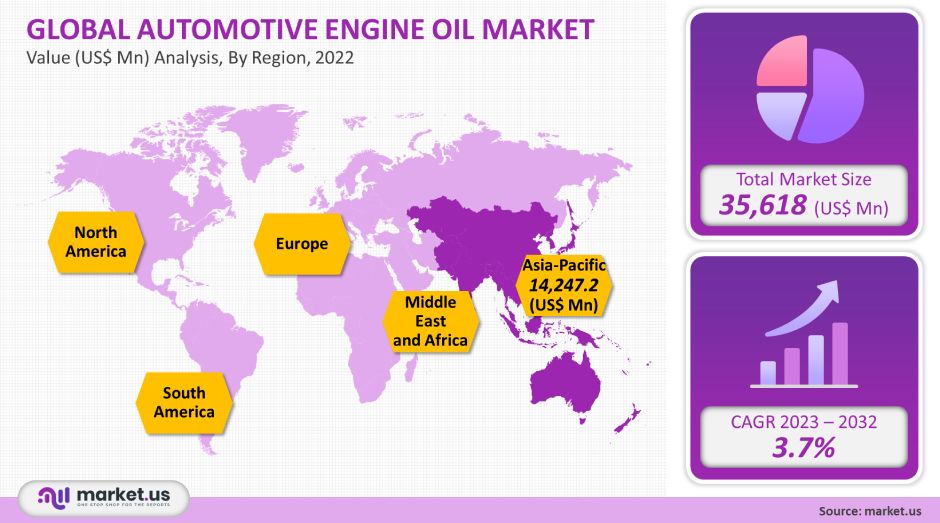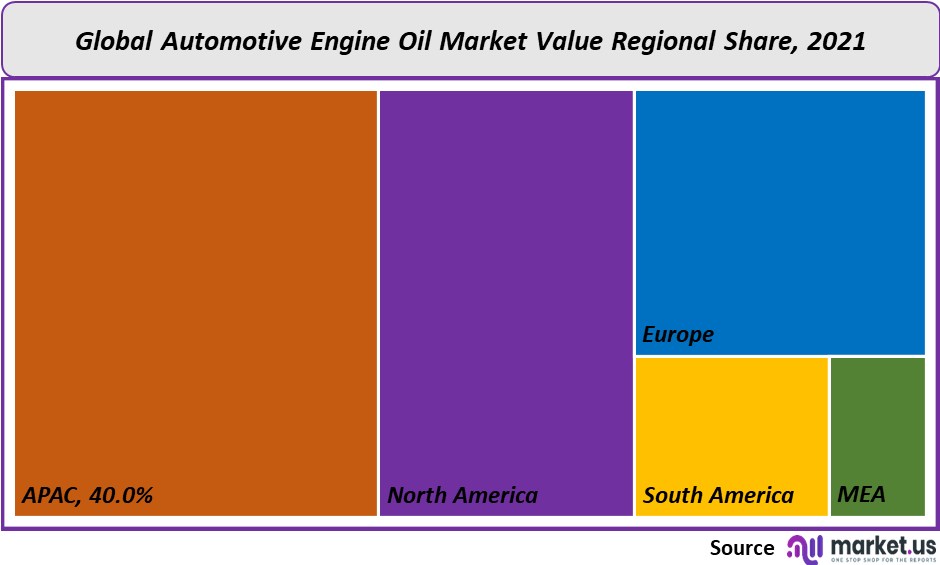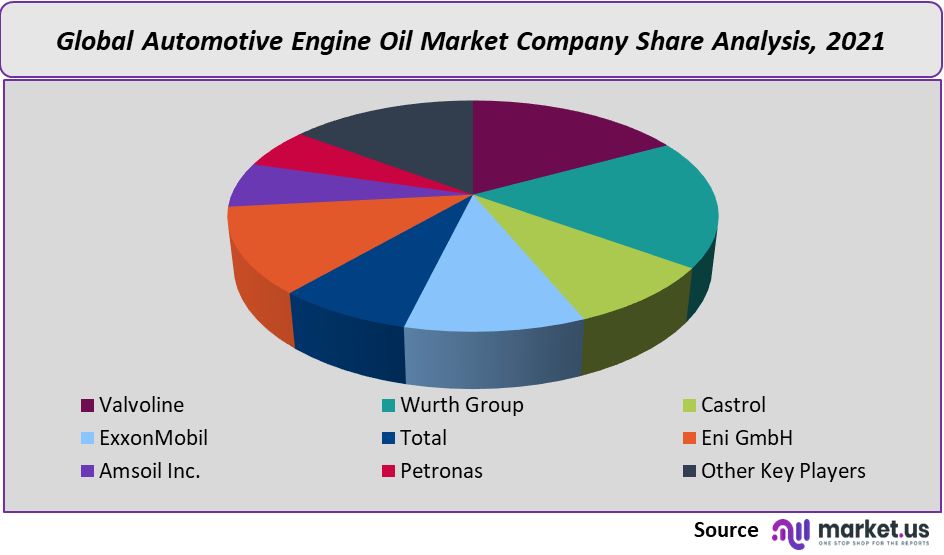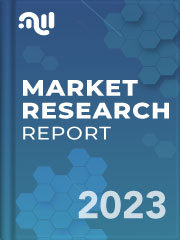Global Automotive Engine Oil Market by Engine Type (Gasoline, Diesel, Alternative Fuels), By Vehicle Type (Passenger Cars, Light Commercial Vehicles, Heavy-Duty Vehicles), By Region and Companies - Industry Segment Outlook, Market Assessment, Competition Scenario, Trends and Forecast 2022-2032
- Published date: Dec 2021
- Report ID: 63199
- Number of Pages: 301
- Format:
- keyboard_arrow_up
Automotive Engine Oil Market Overview:
In 2021, the global automotive engine oil market was valued at USD 35,618 million. It is expected to grow at a CAGR of 3.7% in terms of revenue between 2022-2032.
This can be associated with the increasing automobile production and demand for conventional and synthetic products. The market for automotive vehicles has seen steady growth in the last few years, mainly due to increased consumer spending and a growing population.
Due to the number of technological advances in the automotive industry, the market will experience significant growth over the forecast period. Multinational automobile manufacturers are constantly implementing operational blueprints and tactical vehicle mechanisms that increase the demand for high-performance oil.
Global Automotive Engine Oil Market Scope:
Engine Type Insights:
In 2021, diesel accounted for more than half of the total revenue. The diesel engine is more viscous than natural gas or gasoline-powered engines and has higher performance additives.
Its superior anti-wear load is usually in the form of ZDDP (zinc dialkyl dithiophosphate). Castrol, ExxonMobil, and Royal Dutch Shell hold most of this market share among the many formulators.
In 2021, gasoline was the second largest segment. It is expected that gasoline will grow at a 3.2% CAGR in revenue over the forecast period due to its excellent solubility and high leaching loss resistance.
Ammonia has been an essential pillar in the nitrogen fertilizer industry. It is more nitrogen-rich than any commercially available counterpart. You can apply ammonia directly to the soil or convert it into other nitrogen fertilizers.
Multinationals like HP Lubricants have created their engine oils (HP GASENOL 50W 50) for natural gas- and CNG-powered engines. These oils are used in heavy-duty trucks and in small-sized passenger cars.
This product is designed for a natural gas-based engine and can start at low ambient temperatures. It also protects the engine from nitration or oxidation that often occurs in high-temperature combustion of LNG fuels.

Vehicle Type Insights:
Over the past decade, consumer preferences have changed in the passenger vehicle sector of advanced economies such as North America and Europe.
The desire of consumers to buy vehicles that emit less carbon dioxide, use less fuel and provide exceptional performance is changing and has led to substantial foreign investment in the sector to create a product that meets current market demand.
In 2021, the passenger cars segment accounted for 35% of all revenue, attributed to growing disposable income and a rapidly growing urban population.
Heavy-duty vehicles ranked second in revenue and were expected to record the highest CAGR at 3.7% during the forecast period. This growth can be attributed to increasing urbanization, which has increased off-highway construction vehicle usage.
Manufacturers of engine oil are developing products to reduce emissions. These products are compliant with BSIV compliance on heavy-duty trucks that use modern Selective Catalytic Reduction engines.
The soot produced by lighter engines is usually lower than its heavier counterparts. Heavy-duty engines require more detergents and dispersant additives because they require longer oil drain intervals.
The product’s utility can be applied to all vehicles and can be adapted by customers according to their vehicle application preferences.
Key Market Segments:
Engine Type:
- Gasoline
- Diesel
- Alternative Fuels
Vehicle Type:
- Passenger Cars
- Light Commercial Vehicles
- Heavy-Duty Vehicles
Regional Analysis:
The largest revenue share, at over 40%, was held by the Asia Pacific region in 2021. This growth can be associated with the large consumer base and the increasing production and consumption in countries such as China.
Product formulators like Total are investing more in the Asia Pacific region to tap this growing market. Automotive Multinationals in the region are investing heavily in digitizing production facilities to speed up output delivery.

China is rapidly progressing in automation and robotics, with significant automakers investing heavily in this market. The interval between an oil change is a substantial factor in the product’s success in China and the Asia-Pacific.
The oil change takes place at approximately 30,000 km in regions like Europe and America for ordinary passenger cars.
North America was the second-largest regional segment in terms of revenue in 2021. It is expected to see a CAGR in the following years of 2.9%. This growth can be attributed to the growing demand for commercial vehicles in the E-Commerce and the logistics industry.
Due to its high fuel economy and lower carbon emissions, the country uses significant diesel fuel. According to the U.S. Department of Energy, there have been high sales of diesel-powered vehicles on-road instead of diesel-fuel-driven vehicles.
Кеу Regions and Countries covered іn thе rероrt:
- North America
- US
- Canada
- Mexico
- Europe
- Germany
- UK
- France
- Italy
- Russia
- Spain
- Rest of Europe
- APAC
- China
- Japan
- Korea
- India
- Rest of Asia-Pacific
- South America
- Brazil
- Argentina
- Rest of South America
- MEA
- GCC
- South Africa
- Israel
- Rest of MEA
Key Companies & Market share Insights:
The primary raw materials used in the product’s manufacture are base oil and additives. ExxonMobil, Royal Dutch Shell, and other manufacturers produce their base oils to integrate production vertically. Most manufacturers are integrated at different stages of each value chain stage.
There are three types of distribution channels available in the market: direct supply agreements to industrial customers, third-party distribution channels, and the company’s distribution network.
End consumers are increasingly entering into direct supply agreements to ensure uninterrupted supply and cost savings for the future. Because of the large number of multinational companies that consume variable amounts of the product, third-party logistics is a worldwide phenomenon.

Кеу Маrkеt Рlауеrѕ іnсludеd іn thе rероrt:
- Valvoline
- Wurth Group
- Castrol
- ExxonMobil
- Total
- Eni GmbH
- Amsoil Inc.
- Petronas
- Fuchs Petrolub
- Chevron Group
- Other Key Players
For the Automotive Engine Oil Market research study, the following years have been considered to estimate the market size:
Attribute Report Details Historical Years
2016-2020
Base Year
2021
Estimated Year
2022
Short Term Projection Year
2028
Projected Year
2023
Long Term Projection Year
2032
Report Coverage
Competitive Landscape, Revenue analysis, Company Share Analysis, Manufacturers Analysis, Volume by Manufacturers, Key Segments, Key company analysis, Market Trends, Distribution Channel, Market Dynamics, COVID-19 Impact Analysis, strategy for existing players to grab maximum market share, and more.
Regional Scope
North America, Europe, Asia-Pacific, South America, Middle East & Africa
Country Scope
United States, Canada and Mexico, Germany, France, UK, Russia and Italy, China, Japan, Korea, India and Southeast Asia, Brazil, Argentina, Colombia etc.Saudi Arabia, UAE, Egypt, Nigeria and South Africa
Frequently Asked Questions (FAQ)
Q: What is the Automotive Engine Oil market size in 2021?A: The Automotive Engine Oil market is US$35,618 million in 2021.
Q: What is the CAGR for the Automotive Engine Oil market?A: The Automotive Engine Oil market is expected to grow at a CAGR of 3.7% during 2022-2032.
Q: What are the segments covered in the Automotive Engine Oil market report?A: Market.US has segmented the Automotive Engine Oil market by geography (North America, Europe, APAC, South America, and the Middle East and Africa). By Engine Type, the market has been segmented into Gasoline, Diesel, and Alternate fuels. By Vehicle Type, the market has been further divided into Passenger cars, Light-motor vehicles, and Heavy-motor vehicles.
Q: Who are the key players in the Automotive Engine Oil market?A: Valvoline, Wurth Group, Castrol, ExxonMobil, Total, Eni GmbH, Amsoil Inc., Petronas, Fuchs Petrolub, Chevron Group, American Refining Group, and Other Key Players are the key vendors in the Automotive Engine Oil market.
Q: Which region is more attractive for vendors in the Automotive Engine Oil market?A: APAC accounted for the highest revenue share of 40.0% among the other regions. Therefore, APAC's Automotive Engine Oil market is expected to garner significant business opportunities for the vendors during the forecast period.
Q: What are the key markets for Automotive Engine Oil?A: Key markets for Automotive Engine Oil are the U.S., China, Japan, Germany, UK, India, South Korea, Brazil, and France.
Q: Which segment has the largest share in the Automotive Engine Oil market?A: In the Automotive Engine Oil market, vendors should focus on grabbing business opportunities from the Diesel segment as it accounted for the largest market share in the base year.
![Automotive Engine Oil Market Automotive Engine Oil Market]() Automotive Engine Oil MarketPublished date: Dec 2021add_shopping_cartBuy Now get_appDownload Sample
Automotive Engine Oil MarketPublished date: Dec 2021add_shopping_cartBuy Now get_appDownload Sample - Valvoline
- Wurth Group
- Castrol
- ExxonMobil
- Total SE Company Profile
- Eni GmbH
- Amsoil Inc.
- Petronas
- Fuchs Petrolub
- Chevron Group
- Other Key Players
- settingsSettings
Our Clients
|
Single User
$5,999
$2,999
USD / per unit
save 50% |
Multi User
$7,999
$3,499
USD / per unit
save 55% |
Corporate User
$12,999
$4,499
USD / per unit
save 65% | |
|---|---|---|---|
| e-Access | |||
| Data Set (Excel) | |||
| Company Profile Library Access | |||
| Interactive Dashboard | |||
| Free Custumization | No | up to 10 hrs work | up to 30 hrs work |
| Accessibility | 1 User | 2-5 User | Unlimited |
| Analyst Support | up to 20 hrs | up to 40 hrs | up to 50 hrs |
| Benefit | Up to 20% off on next purchase | Up to 25% off on next purchase | Up to 30% off on next purchase |
| Buy Now ($ 2,999) | Buy Now ($ 3,499) | Buy Now ($ 4,499) |









